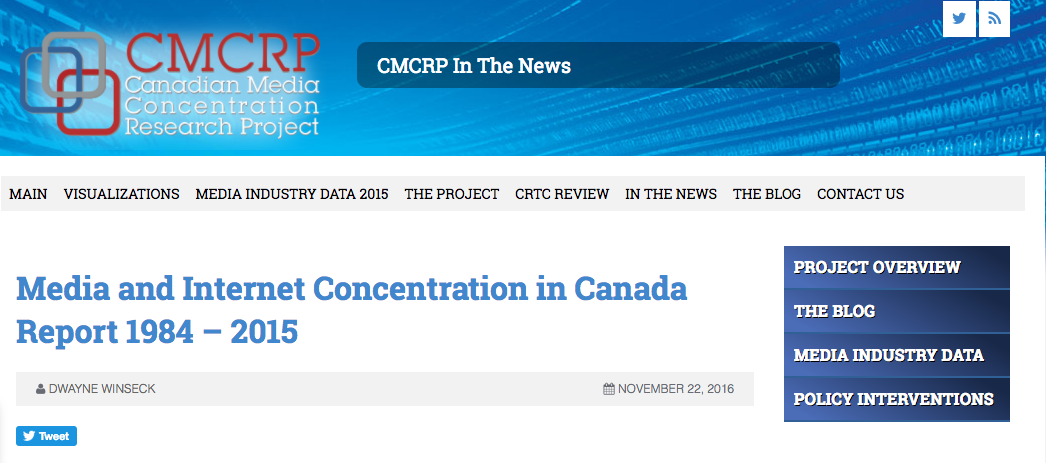What we learned from the latest media concentration report
Canadians are reading news from diverse sources, but newspaper concentration is up.
By H.G. Watson, Associate Editor
It’s been a hard year for journalism—take solace, then, that a lot of people are reading a lot of news.
A media concentration report released in November 2016 by Dwayne Winseck, who leads the Canadian Media Concentration Research Project based at Carleton University in Ottawa, updates research first released in 2012, and updated every year since. Here’s what’s new in the most recent report.
Canadians are reading a diverse amount of news
The good news from the updated report is that Canadians are reading a great deal of news, from a wide variety of source, both Canadian and international. Comscore’s over the last three years show CBC and the Weather Network leading the pack, with Postmedia, Torstar and CTV all cracking the top 10. Newer outlets Vice and BuzzFeed also posted high numbers, along with international outlets New York Times and CNN.
“In terms of where Canadians are getting their news from, we see a fairly high level of diversity here and I think that’s pretty decent—that’s the good news story,” said Winseck.
The bad news is that a lot of the newer startups that have been lauded as the future of Canadian journalism—iPolitics, Canadaland, The Tyee and the National Observer to name a few—don’t even crack the top 60 news sources Canadians are getting their news from.
Consolidation has not been a panacea
Like last year, media concentration remains high in the telecom sector, while radio and magazine ownership is generally fairly diverse. However, with Postmedia’s purchase of the Quebecor papers in 2015, concentration in the newspaper industry is now higher than in previous studies. The deal was approved by the Competition Bureau, and, according to the Globe and Mail, Postmedia CEO and President Paul Godfrey said they planned to keep newsrooms separate—we know that didn’t happen. After the sale finalized, Postmedia owned a full third of the Canadian newspaper industry.
“Consolidation has not been a panacea to the woes of the newspaper industry or journalism,” notes Winseck. “It’s been one of its aggravating causes.” The idea that the audience of a closed newspaper would simply migrate to another regional option doesn’t seem to hold water when you look at the results in the real world.
Google and Facebook dominate the internet ad game
It’s not even really a competition for internet ad sales—Google and Facebook are trouncing every other media organization. In 2015, Google continued to hold on to their 50 percent market share of internet advertising, while Facebook bumped their share 2.4 percent over 2014, to 16.5 percent. The closest media organization was Torstar—with just 2.7 percent market share in 2015. All Canadian media organization saw a reduction in market share from 2014 to 2015.
The Trump effect
Moves south of the border could have an effect on Canada. President-elect Donald Trump has named Jeffrey Eisenach as his chief telecoms policy advisor. According to Politico, he’s know as a “regulatory foe,” which could spell trouble for advocates of open Internet.
The CRTC also potentially loses an ally in the Federal Communications Commission. “FCC has been a close cousin of the CRTC, that CRTC could draw some moral support for the position it’s been drawing out,” said Winseck.
Editor’s note, Jan. 25, 2017: An earlier version of this story included the wrong date for the first media concentration report. We apologize for the error.
H.G. Watson was J-Source's managing editor from 2015 to 2018. She is a journalist based in Toronto. You can learn more about her at hgwatson.com.

